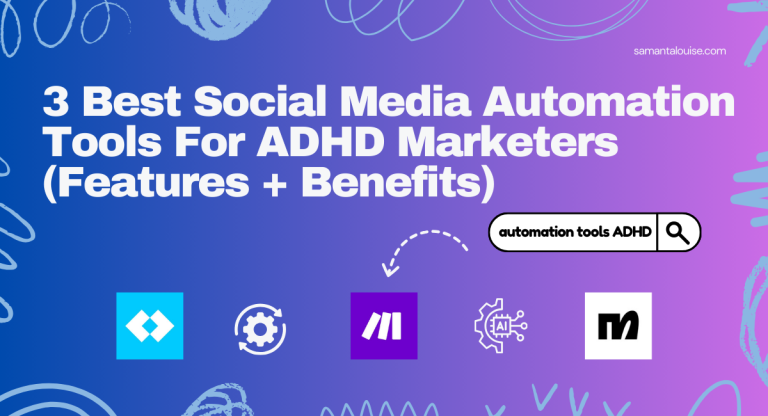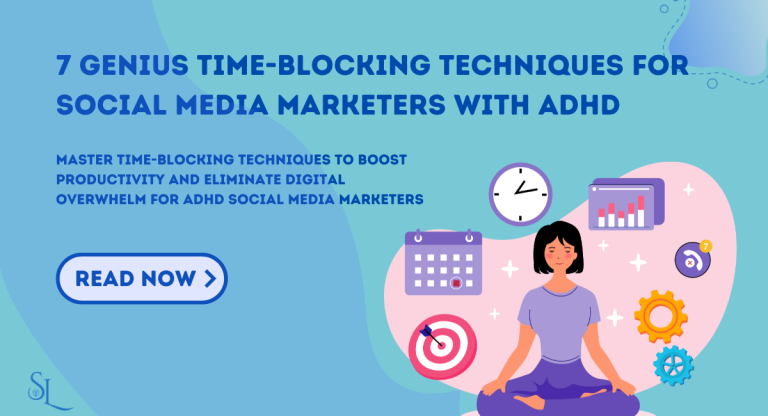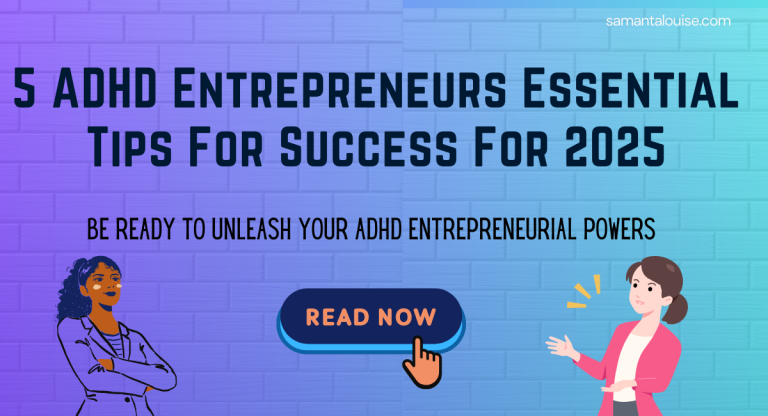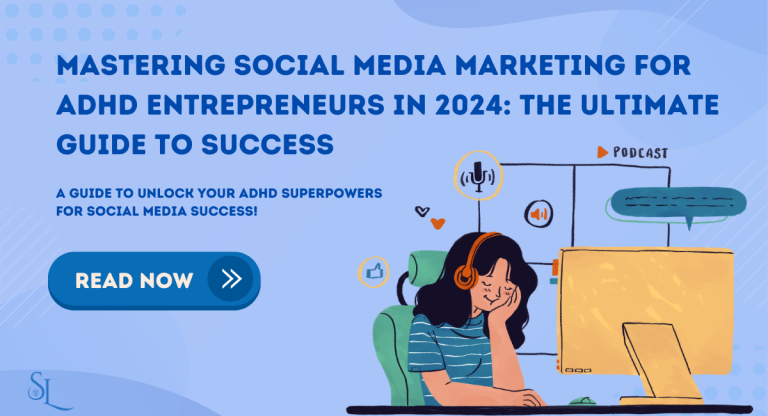5 Essential Pomodoro Technique ADHD Hacks for Digital Marketers
Take one distracted brain, add a splash of terrible time management, and garnish with ADHD – congratulations, you’ve just mixed the world’s most chaotic productivity cocktail. But before you toast to missed deadlines, try the Pomodoro Technique ADHD hacks that positively transformed my digital marketing productivity.
If you haven’t heard of The Pomodoro Technique, you are in for a life-changing productivity hack and if you have ADHD just like me, you are in for a delicious treat. This isn’t just another productivity tool; it’s that missing puzzle piece you have been looking for in your messy room.
The hardest part about social media marketing with ADHD is consistency. The best ADHD-friendly method I have found is the Pomodoro Technique but I had to adjust it to match my ADHD brain challenges before I add it to my ultimate social media marketing guide for ADHD social media marketers.
In this article, we will go over the hacks I implemented to make this focus management technique a winner for our ADHD minds.
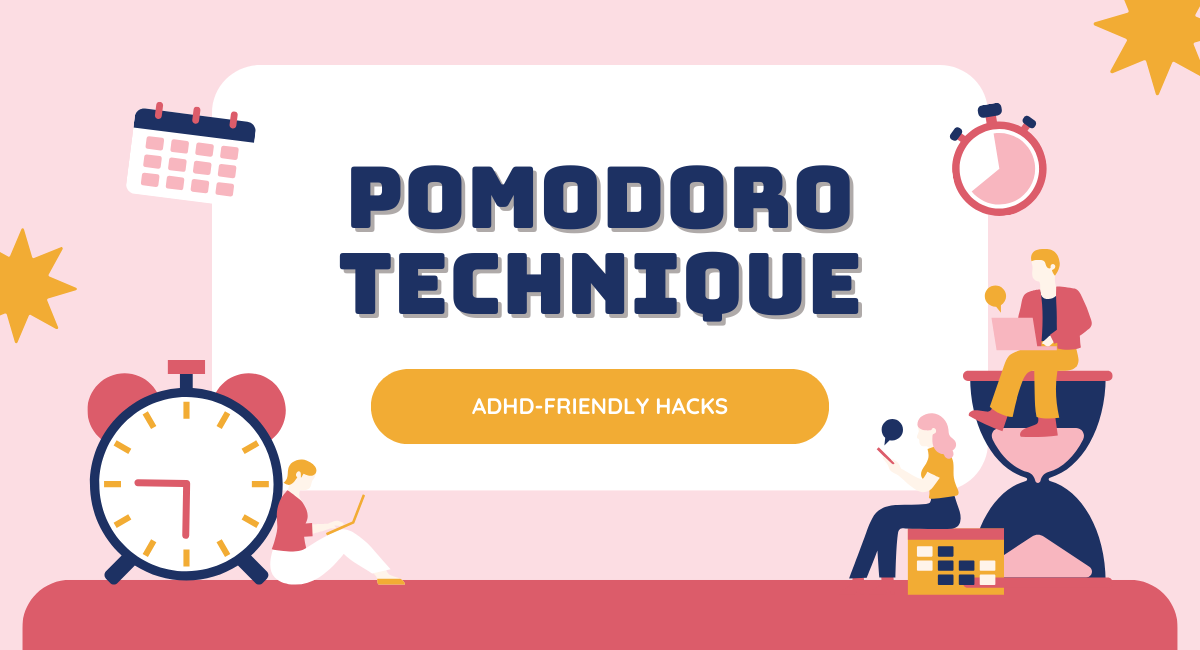
Does Pomodoro Technique Work for ADHD Digital Marketers?
Before we jump into these game-changing hacks, let’s address the most important question: is the Pomodoro technique for ADHD digital marketers a real solution or just a fad?
After years of struggling with ADHD time management and watching my fellow ADHD digital marketers complain online about how they can barely go through their to-do lists, I finally discovered why the Pomodoro Technique ADHD time management method works differently for ADHD brains. The science behind this is fascinating.
Our ADHD executive function affects how we process time and maintain work concentration. While a neurotypical might easily work for hours straight, our brains operate more like a browser with multiple tabs open – constantly task-switching and seeking new stimulation. That’s where the Pomodoro technique ADHD hacks come in handy.
My digital marketing task management was in complete chaos before I stumbled upon Pomodoro timer apps, which help me to stay focused for a set time period and take short breaks in between to reset. What makes this technique so effective is the breakdown of overwhelming social media marketing projects into manageable chunks.
Instead of staring at an endless to-do list, I use time-blocking strategies to segment my day. For example, I’ll dedicate one Pomodoro to social media time blocking, another to content planning, and so on. The key is implementing proper Pomodoro break activities that prevent burnout while maintaining momentum.
What is the Pomodoro Technique and How Does It Work?
The Pomodoro Technique is a time-blocking technique that acts as a timer. You focus for 25 minutes (that’s one Pomodoro), then a 5-minute break to recharge. Think of it as interval training for your work concentration. Here’s how it works:
- Pick one task to complete
- Set a timer for 25 minutes
- Focus only on that task for 25 minutes
- Take a 5-minute break once the 25 minutes is over
- Repeat until you complete the task
After 4 Pomodoros, reward yourself with a longer 15-30 minute break. For us ADHD productivity seekers, it’s perfect because:
- Short bursts match our natural focus patterns
- Regular breaks prevent burnout
- Timer creates urgency (our ADHD brain loves deadlines!)
- Small wins fuel motivation
Now let’s explore the hacks that make this Pomodoro Technique ADHD-friendly and more effective for our ADHD brain.
Hack 1: Adjust The Time Set According to the Task Difficulty Level
After years of struggling with the traditional time-blocking strategies, I’ve realised that the best approach for my ADHD brain is to be flexible. Through experimentations with the Pomodoro Technique, I’ve discovered that for me, content creation thrives in 40-minute blocks, while data analytics works better in 20-minute sprints.
Therefore, when setting the timer for your tasks, you should not be rigid with the 25-minute rule, instead, observe your productivity pattern and adjust the time accordingly. Let me break down my marketing task management system for better understanding:
For Content Creation (40-minute blocks):
- Perfect for deep-dive writing sessions
- Aligns with natural focus enhancement periods
- Includes 10-minute breaks for optimal work concentration.
For Social Media (30-minute blocks)
- Optimised for my work speed
- Allow me to use my digital marketing tools and apps
- Gives me enough time to research
I have emergency buffer zones of 30 minutes between major blocks for unexpected tasks, delays, or creative bursts. My digital marketing efficiency has really improved since then. The built-in flexibility is what makes this technique work. Some days, when hyperfocus kicks in during content creation ADHD, I might extend a block.
The key is using the right Pomodoro timer apps that allow customization while maintaining structure. I’ve found that combining these tools with marketing task batching creates a powerful system for sustained productivity without burnout.
Hack 2: Use Digital Tools That Help You Track Your Pomodoros
During my career as a digital marketer, I have tested countless tools and apps, and let me be honest—not all of them have been helpful. Some of them have even added to the digital noise and reduced my productivity but I have compiled a list of the best ADHD-friendly social media tools and apps that worked for me and enhanced my Pomodoro technique ADHD time-blocking strategy.
First, let’s dive into the Pomodoro timer apps that genuinely helped me improve my productivity:
- Forest App: I use this tool primarily as a Chrome Browser extension. It helps me focus on specific tasks for set periods and has an excellent visual representation of your focus time with the “Tree Planting” feature. Each time I start a new timer for a specific task, I can grow a tree both digitally and physically (through their tree planting program). The motivation lies in the idea if I do not complete my task and focus until the timer goes off, my tree will wither
- Focus To-Do: I use this app on my mobile phone to curb distractions. Once the Pomodoro timer starts, the phone screen needs to face down. Otherwise, the timer resets. I can also set tasks and checklists for social media projects and work on them using the timer with break intervals. At the end of the day, I can check my analytics to know how long I have been focused on the project throughout the day.
If you want to time-track your projects whilst having them all in one place, ClickUp is the right tool. You can create project briefs, assign specific durations you want to work on them and set deadlines. As you work on the projects, you can add a checklist, comments and notes.
Here’s what makes these tools specifically effective for ADHD-friendly workspace setups:
- Visual progress indicators
- Customizable notification systems
- Integration capabilities for marketing organization
- Flexible task completion strategies
This Pomodoro Technique ADHD hack is perfect if you want a centralised task management system. I’ve found that combining these tools creates a powerful ecosystem for focus management ADHD. For example, I use Forest App during content creation blocks, synchronized with ClickUp’s time tracking to activate my deep focus mode. You could add Freedom, an app to block distracting websites, into the arsenal to eliminate unwanted distractions.
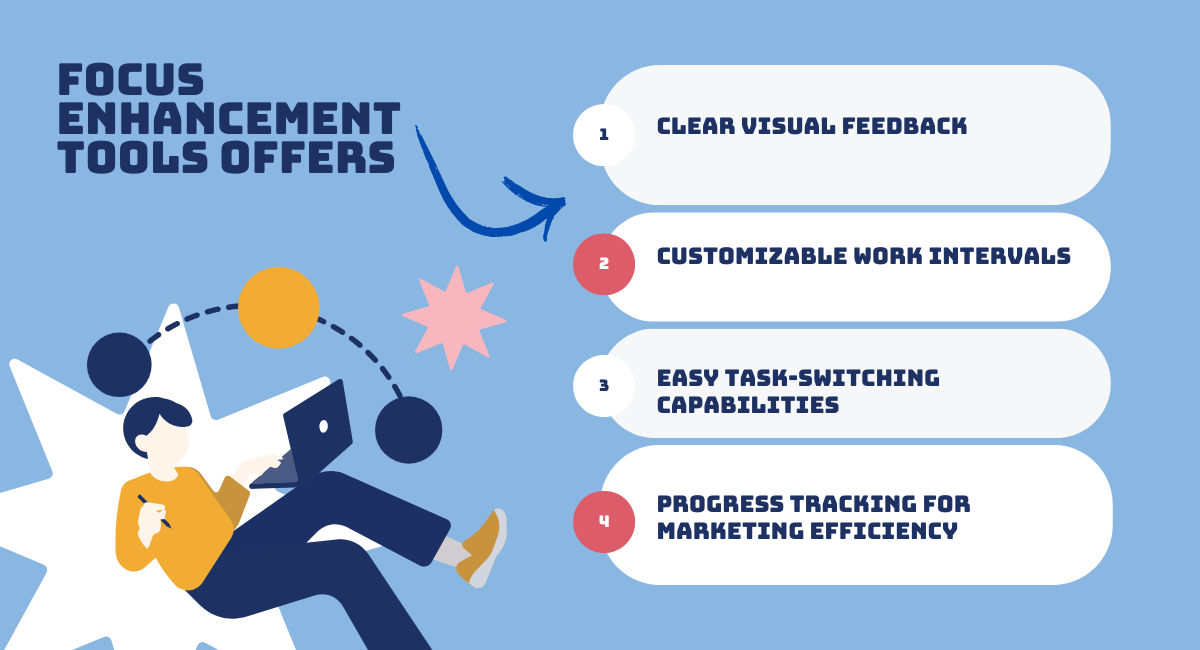
The key to success with these ADHD productivity apps is strategic implementation. Don’t try to adopt everything at once. Start with one tool that addresses your biggest marketing time management challenge, master it, then gradually add others. This approach prevents overwhelm and ensures each tool serves your workflow.
Hack 3: Do Some Strategic Task Batching For Maximum Pomodoro Technique Impact
Strategic marketing task batching is a lifesaver when it comes to digital marketing organizations. I have refined this system specifically for myself as I have struggled with constant context-switching in the past.
The key is to organise your main social media tasks or projects into batches. You should categorize your work and group similar tasks together to increase focus and productivity. Let’s have a look at how I do it.
I group all my content creation work in one batch:
Content Creation Blocks (2-hour sessions broken down into 3 Pomodoros of 40 Minutes):
- Writing all blog Pinterest posts for the week
- Creating social media captions in bulk
- Designing multiple graphics simultaneously
- Recording several videos back-to-back
Social Media Management (60-minute blocks broken down into 3 Pomodoros of 20 minutes):
- Scheduling posts across platforms
- Engaging with followers
- Analyzing metrics
- Planning future content
Administrative Tasks (60-minute sprints broken down into 3 Pomodoros of 20 Minutes):
- Email management
- Client communications
- Invoice processing
- Report generation
The key to making this ADHD workflow optimization work is grouping similar tasks to minimize the mental energy lost in task switching. For instance, when I’m in “content creation.
I’ve found that combining this batching approach with focus enhancement tools dramatically improves my work concentration. Using Pomodoro modifications, I’ll often work in 45-minute sprints within these larger batched blocks, taking strategic breaks to maintain energy.
The real breakthrough comes from aligning these batched sessions with your natural energy patterns. For instance, I schedule creative work during my peak focus hours and save administrative tasks for when my digital marketer focus naturally dips.
Hack 4: Have ADHD-Friendly Break Activities That Boost Creativity
If you want your Pomodoro Technique ADHD strategy to work, you need to address one crucial part of it: the breaks. Even if the breaks do not involve actual work, they are equally important in fueling your productivity sessions. For ADHD marketers, traditional “sit quietly and breathe” breaks often backfire. Instead, I’ve developed a system of dynamic break activities that actually enhance our creative marketing capabilities while giving our brains the reset they need.
Here’s my best framework for ADHD work strategies during breaks:
Movement-Based Reset Activities (5-10 minutes):
- Quick desk yoga sequences
- Office-friendly stretching routines
- Standing desk transitions
- Brief walking sessions
Creative Recharge Methods (10-15 minutes):
- Rapid sketching exercises
- Color palette exploration
- Mind mapping new ideas
- Inspirational pin-boarding
Focus Enhancement Activities (5 minutes):
- Brain-training games
- Pattern recognition exercises
- Quick visualization practices
- Breathing techniques for work concentration
The key is avoiding the tempting but counterproductive social media trap. Instead of reaching for your phone during breaks, which can lead to endless scrolling and decreased marketing efficiency, engage in activities that genuinely refresh your creative energy.
My favorite break activity is using Nibble App or Elevate App to solve puzzles or solve a brain teaser. It is highly stimulating and helps me stay in the mood for work. If I shift to browsing social media entirely, it ruins my productivity and only causes me to procrastinate before starting the next task. I only engage in complete leisure activities once I am entirely done with work for the day.
Effective breaks are crucial for sustaining digital marketer focus throughout the day. By choosing activities that complement rather than compete with your marketing work, you’re setting yourself up for sustained creative success.
Hack 5: Introduce Rewards Into Your Pomodoro Technique ADHD Workflow
Many individuals who try the Pomodoro Technique ADHD method often quit using it because they cannot see the benefits but very often, the failure’s reason does not have anything to do with the method in itself but with the incentives associated with it.
What is your motivation for staying focused repeatedly throughout the day? If you cannot find any, this method will fail. You need to find rewards that motivate you to work.
The more difficult the work is, the better the reward should be. The longer the sprint is, the better the reward should be. This is a surefire way to keep you working but you have to be disciplined enough to follow through.
Here’s how I do it for myself:
- For longer Pomodoros (40 minutes +), I take more relaxing breaks instead of stimulating one
- For more difficult task, I grant myself with more satisfying rewards.
I am a huge fan of Chinese TV shows so this is my most satisfying reward. For big projects, I reward myself by starting to watch new sensational dramas that I have been looking to watch for a while. For example, I wanted to create 15 reels for Instagram but kept procrastinating. Then I set a Chinese TV show watchtime as a reward. I told myself if I completed the 15 reels, I could watch 5 episodes.
After completing multiple Pomodoros, you should grant yourself longer breaks. Let’s say you have 5 Pomodoros of 30 mins, that’s over two hours of work, so you should take longer breaks – 20-30 minutes.
One more tactic to use in this Pomodoro technique ADHD hack is to keep someone accountable by letting someone know about the rewards that should be unlocked when you complete a specific task. I always tell someone close to me about my objectives and which reward to unlock when I complete them, in this way, it ensures I stay disciplined and do not unlock rewards I did not earn.
This process can be tricky if you are not a disciplined person but with the right tools and accountability framework, you can do it and accomplish your tasks without any issues.
Troubleshooting Common Pomodoro Technique ADHD Challenges
After years of trial and error, I’ve developed practical solutions for those moments when our marketing task management threatens to spiral out of control. Even with these hacks, you can fall into the pitfall of procrastination but here’s how to avoid them:
- Manage your deadlines in an ADHD-friendly way
- Use visualization boards for your projects
- Insert buffer time blocks for unexpected changes
- Use the Eisenhower Priority matrix system for marketing organization
- Create a flexible task management strategy
- Have flexible planning templates
- Have easy-to-edit documentation systems
- Always have a backup plan for your resource allocation
- Create a focus recovery protocol
- Design quick reset routine plans to put you right on track if you slack off
- Track your progress every step of the way
- Have a checklist in place for resuming tasks
What to do if everything fails?
We want to avoid this situation at all costs but let’s be honest, the ADHD brain is unpredictable and you can sometimes go into a cycle of procrastination and demotivation, but this does not mean you should give up.
I have experienced such phases and by now, I have figured out that the best way to deal with it is to accept it and deal with it. Nothing is going to be 100% perfect but you can have strategies in place to help you overcome such situations.
I keep a “crisis management toolkit” that includes:
- Pre-written email templates
- Decision-making flowcharts
- Emergency contact lists
- Step-by-step recovery procedures
For maintaining marketing efficiency during challenging periods, I’ve found that combining these solutions with visual cues and physical reminders helps maintain momentum
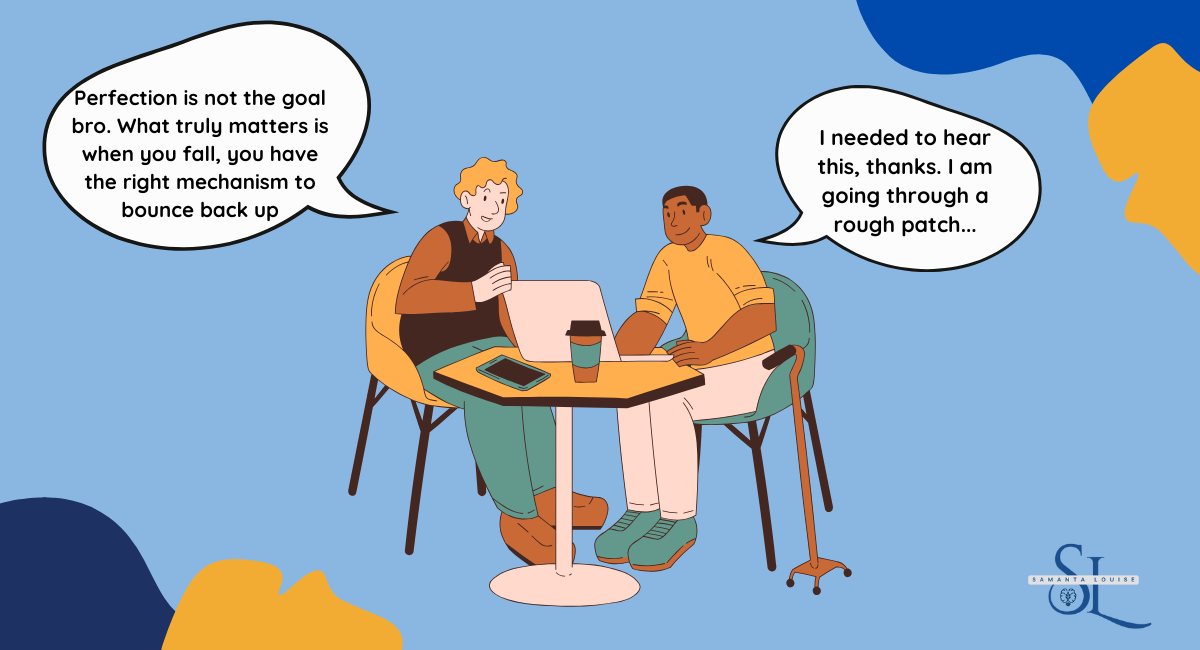
Final Words…
The goal isn’t perfection – it’s progress and professionalism. These systems create a safety net for those moments when ADHD symptoms collide with marketing demands, ensuring we can maintain consistent quality in our work despite the challenges.
Pro tip: Document your successful troubleshooting experiences. This creates a personal playbook of marketing productivity tools that you know work specifically for your ADHD brain and your unique marketing challenges.
Want to stay in the loop for ADHD-friendly digital marketing tips and free resources ever month? Subscribe to my Newsletter.
Let’s be 1% better every day.

